By Pete Vack
Color photos by Harry Hurst
Thanks to the kind offices of the Simeone Foundation, VeloceToday was recently given the opportunity to drive two rare pre-war Alfa Romeos. While driving the “Legendary” 2.3 Castagna was a dream come true, it was perhaps even more fortunate to have been able to sample an even rarer Alfa–a 1925 RLSS, “Merosi’s Masterpiece” as some have called the breed. Rare, did we say? How about 392 ever produced, of which perhaps a dozen are left, scattered across the globe. To see one is an event; to drive one is to experience motoring’s Shangri-La. Here is our report:
Being able to drive both the 8C 2300 and the RLSS meant that we were given the even rarer opportunity to drive the work of both Giuseppe Merosi and Vittorio Jano. We’ll tell you which was more fun an bit down.
But it’s important to emphasize that the cars of Merosi and Jano, even though both Alfa Romeos, can’t really be compared head to head. Another important item to note is that Merosi’s RL (for Romeo Type L) were basically street cars; yes, raced by Ferrari and others, but the RL and its variants were built for the boulevard. Although Luigi Fusi stated that the RL engine was initially designed for the upcoming 3 liter racing formula in 1920, racing was already dominated by straight eight DOHC engines, so it’s difficult to see what the Merosi–or Fusi had in mind. The RL had a cast iron block and detachable iron head with a single cam in the block operating two overhead valves per cylinder; hardly a way to go racing, even in 1920. (Nicholas Lancaster discusses the Merosi RLs in depth, part 1)
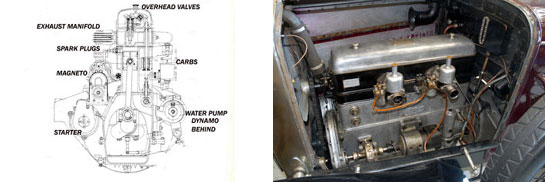
Diagram at left shows the OHV and location of ancillaries; photo shows S.U. carbs and the water pump and generator driven from the front. Block is cast iron even though looking like aluminum.
At the Simeone Foundation, I watch as Curator Kevin Kelly gets the RLSS ready for us. He is trying to get gas to the combustion chambers and fiddles with the two large choke-less S.U. carbs—original Zeniths are around somewhere but not used—and gets back in the car to pump up the air to the gas tank. Two to three lbs of air pressure on the fuel tank force feeds the carbs; before the car starts this must be done by hand via a pump handle on the dashboard. Once running, a mechanical pump keeps the air pressure on the fuel tank. Why they didn’t just make the mechanical air pump a mechanical fuel pump is not known. Kevin fiddles further, hits the electric starter and suddenly the huge 3 liter six cylinder engine comes to life. There is smoke all over, but he has made sure that the upper end is well lubricated—seems that the valve gear must be oiled manually every so often as there is no oil pressure to the upper end of the engine. The excess oil burns off and the engine settles down to an acceptable idle. There is a huge belt for the aluminum radiator fan, so enormous I wonder about the collateral damage if it were to break while at speed. Out the back of this venerable engine comes about 83 hp at 3600 rpm to push a chassis weighing about 3200 lbs plus the considerable weight of the special bodywork.
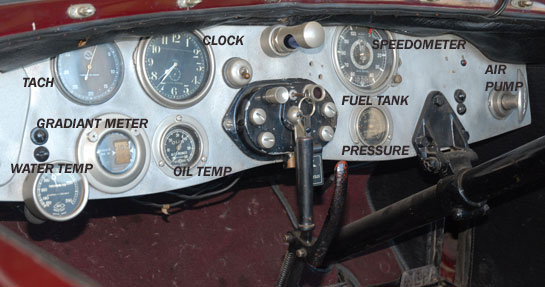
A popular accessory of the era was a gradient meter which would determine how steep the hill and therefore what gear to use. Not identified on the photo is the center grouping with the starter button, key, fuses behind the aluminum screws and the hooded light over the key.
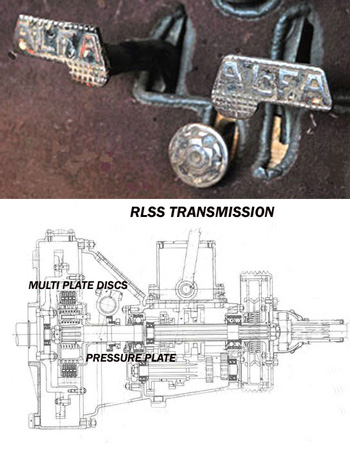 The primary operational differences between this, a car from the early 1920s, (the first RL was actually introduced in October 1921) and moderns are not that great. The center throttle pedal, brakes operated via a series of flat steel cables, manual spark retard /advance and a multi-plate clutch make driving the car more interesting but not particularly more difficult. Even the multi-plate clutch is easy to use and smooth. There are a series of metal discs between the pressure plate and the flywheel instead of one lined clutch disc as is more common, but it works well unless slipped too much, which will warp the metal discs.
The primary operational differences between this, a car from the early 1920s, (the first RL was actually introduced in October 1921) and moderns are not that great. The center throttle pedal, brakes operated via a series of flat steel cables, manual spark retard /advance and a multi-plate clutch make driving the car more interesting but not particularly more difficult. Even the multi-plate clutch is easy to use and smooth. There are a series of metal discs between the pressure plate and the flywheel instead of one lined clutch disc as is more common, but it works well unless slipped too much, which will warp the metal discs.
Please take the time to contribute and keep VeloceToday coming to your inbox every week. It’s easy and safe. Simply click here for details. 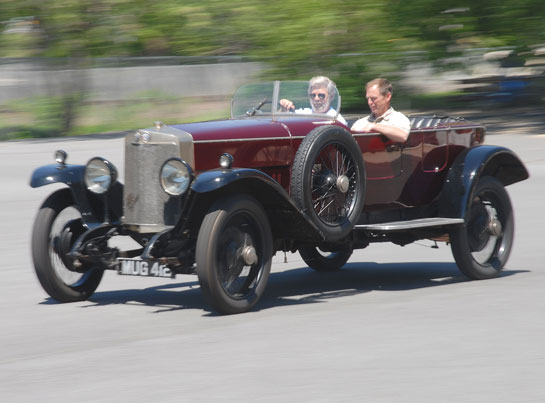 [/caption]
[/caption]
Driving it starts to become enjoyable and even comfortable after only a few minutes. Fears reside, this is manageable, and as Kevin would say, it is a car that one might consider driving coast to coast. That couldn’t really be said of the 8C 2300, which was a true performance car, but the RLSS was an accomplished road warrior. It could cruise at 70 mph all day, the acceleration was adequate (Motor Sport obtained 60 mph in 17 seconds) and while the gear rations often left something to be desired, there wasn’t much it couldn’t do in comfort and style, aided by a somewhat long wheelbase of 10 foot 3 inches. How weatherproof remains to be seen, but we can assume that even at best, tops and side curtains of the era were marginally effective.
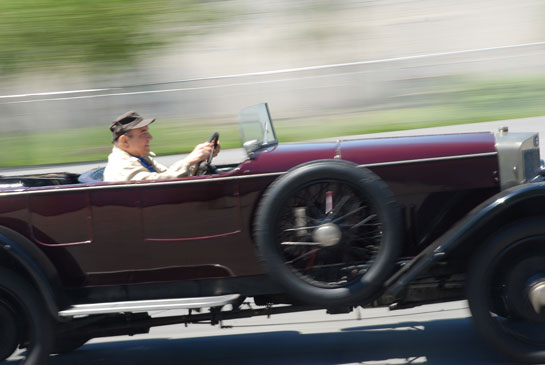
Fred Simeone behind the wheel of the RLSS, which he bought at the Bonhams Auction at Goodwood in 2002.
My preconceived notions about cars of the 1920s were shifting. It was not difficult to drive, but enjoyable, fast enough, handled well and the brakes weren’t dastardly. It might be well said however that the RLSS was not quite your average Grandfather’s car. It was in many respects, well ahead of the game of the day and was suitable transportation for Mussolini, the Aga Khan (whose son Aly would marry Rita Hayworth, drive off to a honeymoon in an Alfa and die in a Lancia), the Prince of Siam and other notables. I stopped driving after what I thought was as suitable length of time, that is before I got black flagged, and found Fred Simeone was there waiting to take his turn driving the RLSS. Simeone later related the story about how he recognized this unique Alfa from the unique British license plates. But that’s another story.
Having that rare opportunity to drive both a Merosi Alfa and a Jano Alfa, one is obligated, I suppose, to give an opinion of which is preferable. Clearly, it is not a fair contest, but even as enjoyable and eye opening the RLSS was, it would nevertheless be less than truthful if I didn’t say that the nod must go to the Jano 8C2300. Merosi’s stock has skyrocketed though, after being given the opportunity to not only see, but drive one of his most famous designs.Next week we’ll present the history of this interesting car and why Fred Simeone never forgets a MUG.

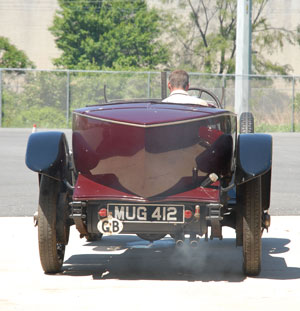
since gasoline is a poor lubricant in a mechanical fuel pump (or in a SPICA injector pump for that matter) – unless you add upperlube to the fuel, they may have preferred the pressurized fuel tank approach. don’t tell any of the people who were driving ford pintos & had their tailfeathers roasted.
i was working for mobil oil in 1953-54 and we were developing fuel additives for fuel-injected engines. the only thing available on the market @ that time was a 300SL, so a few of us had the unpleasant duty of tooling up & down the NJ turnpike for hours on end to accumulate miles prior to teardown & inspection.
multiplate clutch – as you know my milano has a F&S 2-plate unit, works fine, nice & smooth but due to its location in the car no cooling air can get in & if you slip it too much you will get a bad smell out of the clutch. avoid uphill stopsigns where there is lots of cross traffic.
> jack